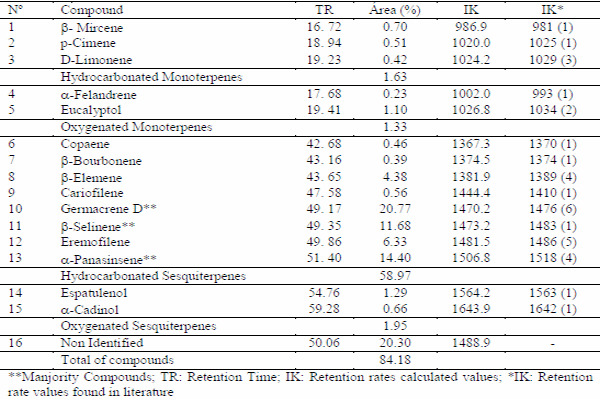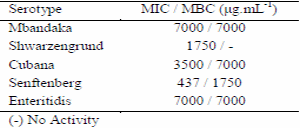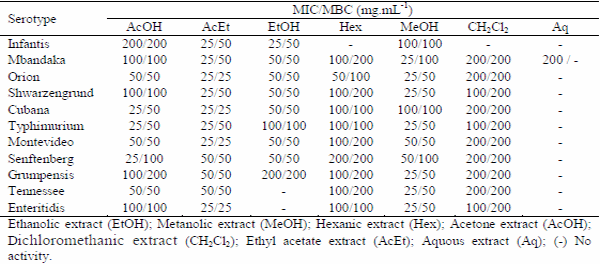Chemical composition and antibacterial activity of essential oil and leaf extracts of Zanthoxylum caribaeum Lam. against serotypes of Salmonella
The present study aimed to identify and quantify the components of the essential oil of Zanthoxylum caribaeum and to evaluate the antimicrobial potential of different plant extracts and the essential oil of this plant against different serotypes of Salmonella enterica, which is of greater occurrence and isolated in the western region of Parana, Brazil. The extraction of the essential oil was performed using Clevenger apparatus and the chemical composition was determined by Gas Chromatography coupled to Mass Spectrometry (GC-MS). The extracts were obtained through different solvents (ethanol, methanol, hexane, acetone, dichloromethane, ethyl acetate and distilled water). The antibacterial activity was carried out according to the broth microdilution technique. The GC-MS analysis resulted in the identification of 15 main components, all terpenes, representing 63.88% of the total essential oil. The major compounds identified were Germacrene-D (20.77%), α-Panasinsene (14.40 %) and β-Selinene (11.68 %). The essential oil presented antibacterial activity against 5 serotypes of Salmonella enterica, with MIC and MBC ranging from 7000 to 437 μg.mL-1. While MIC and MBC from the range from 200 to 25 mg.mL-1, being effective to most serotypes of S. enterica, with the exception of the aqueous extract. The results suggest that the essential oil and leaf extracts of Z. caribaeum represent an alternative for the control of S. enterica in the poultry sector, in this way reflecting a new perspective for studies with natural products.
Keywords: minimum bactericidal concentration, minimum inhibitory concentration, gas chromatography, microdilution, natural products



ADAMS, R.P. Identification of Essential oil Components by Gas Chromatography/Mass Spectrometry. 4 ed. Carol Stream, Illinois: Allured Publishing Corporation, 2007. 804p.
AL-HABIB A.; AL-SALEH E.; SAFER, A.; AFZAL, M. Bactericidal effects of grape seed extracts on methicillinresistant Staphylococcus aureus (MRSA). The Journal of Toxicological Sciences [online], v.35, p.357-364, 2010.
BAKKALI, F.; AVERBECK, S.; AVERBECK, D.; IDAOMAR, M. Biological effects of essential oil: a review. Food and Chemical Toxicology [online], v.46, n.2, p.446-75, 2008.
CECHINEL-FILHO, V.; YUNES, R.A. Estrategias para a obtencao de compostos farmacologicamente ativos a partir de plantas medicinais: conceitos sobre modificacao estrutural para otimizacao da atividade. Química Nova [online], v.21, n.1, p.99-105, 1998.
DELGADO-ADAMEZ, J.; FERNANDEZ-LEON, M.F.; VELARDO-MICHARET, B.; GONZALEZ-GOMEZ, D. In vitro assays of the antibacterial and antioxidant activity of aqueous leaf extracts from different Prunus Salicina Lindl. cultivars. Food and Chemical Toxicology [online], v.50, p.2481–2486, 2012.
FRUTUOSO, A.E.; NASCIMENTO, N.T. do; LEMOS, T.L.G.; COELHO, E.L.; TEIXEIRA, D.M.A. Oleos essenciais aplicados em alimentos: Uma revisao. Revista Brasileira de Pesquisa em Alimentos [online], v.4, n.2, p.69-81, 2013.
GUTIERREZ, J.; BARRY-RYAN, C.; BOURKE, P. The antimicrobial efficacy of plant essential oil combinations and interactions with food ingredients. International Journal of Food Microbiology, v.124, n.1, p.91-97, 2008.
KOTTWITZ, L.B.M.; BACK, A.; LEAO, J.A.; ALCOCER, I.; KARAN, M.; OLIVEIRA, T.C.R.M. Contaminacao por Salmonella spp. em uma cadeia de producao de ovos de uma integracao de postura comercial. Arquivo Brasileiro de Medicina Veterinária e Zootecnia[online], v.60, n.2, p.496-498, 2008.
KUMAR, K.A.; NARAYANI, M.; SUBANTHINI, A.; JAYAKUMAR, M. Antimicrobial activity and phytochemical analysis of citrus fruit peels - utilization of fruit waste. International Journal of Engineering Science and Technology [online], v.3, p.5414-5421, 2011.
LEE, O.H., LEE, B.Y. Antioxidant and antimicrobial activities of individual and combined phenolics in Oleaeuropaea leaf extract. Bioresource Technology [online], v.101, n.10, p.3751–3754, 2010.
LIU, W.; LIU, B.; ZHU, X.; YU, S.; SHI, X. Diversity of Salmonella isolates using serotyping and multilocus sequence typing. Food Microbiology [online], v.28, n.6, p.1182-1189, 2011.
MAJOWICZ, S.; MUSTO, J.; SCALLAN, E.; ANGULO, F.J.; KIRK, M.; O'BRIEN, S.J.; JONES, T.F.; FAZIL, A.; HOEKSTRA, R.M. The global burden of nontyphoidal Salmonella gastroenteritis. Clinical Infectious Diseases [online], v.50, n.6, p.882-889, 2010.
NANASOMBAT, S.; WIMUTTIGOSOL, P. Antimicrobial and antioxidant activity of spice essential oils. Food Science and Biotechnology [online], v.20, n.1, p.45-53, 2011.
OLIVEIRA, A.P.; SOLA, M.C.; FEISTEL, J.C.; MOREIRA, N.M.; OLIVEIRA, J.J. Salmonella enterica: genes de virulencia e ilhas de patogenicidade. Enciclopédia Biosfera, Centro Cientifico Conhecer [online], v.9, n.16, p.1947-1972, 2013.
PANDINI, J.A.; PINTO, F.G.S.; SCUR, M.C.; ALVES, L.F.A; CASTILHO, C.M. Antimicrobial, insecticidal, and antioxidante activity of essential oil and extracts of Guarea kunthiana A. Juss. Journal of Medicinal Plant Research, v.9, n.3, p.48-55, 2015.
PATINO, O.J.; CUCA, O.J. Monophyllidin, a new alkaloid L-proline derivative from Zanthoxylum monophyllum. Phytochemistry Letters [online], v.4, n.1, p.22-25, 2011.
PIRANI, J.R.; GROPPO, M. Rutaceae. In:Lista de Espécies da Flora do Brasil. Jardim Botanico do Rio de Janeiro, 2015. Disponivel em: <http://floradobrasil.jbrj.gov.br/jabot/flora dobrasil/FB212>. Acesso em: 03 mar 2017.
SARTORATTO, A. ; MACHADO, A.L.M.; DELARMELINA, C.; FIGUEIRA, G.M.; DUARTE, M.C.T.; REHDER, V.L.G. Composition and antimicrobial activity of essential oils from aromatic plants used in Brazil. Brazilian Journal of Microbiology [online], v.35, n.4, p.275-280, 2004.
SCUR, M.C.; PINTO, F.G.S.; BONA, E.A.M.; WEBER, L.D.; ALVES, L.F.A.; MOURA, A.C. Occurrence and antimicrobial resistance of Salmonella serotypes isolates recovered from poultry of Western Parana, Brazil. African Journal of Agricultural Research [online], v.9, n.9, p.823-830, 2014.
SCUR, M. C.; PINTO, F. G. S.; BONA, E.A.M.; WEBER, L.D.; FRUET, T.K.; SORESINI, G.C.G. Atividade de desinfetantes frente a sorotipos de Salmonella isolados de granjas avicolas. Revista Brasileira de Saúde e Produção Animal [online], v.17, n.4, p.677-684, 2016.
SILVA, T.R.G.; MARTINS, T.D.D.; SILVA, J.H.V.; SILVA, L.P.G.; PASCOAL, L.A.F.; OLIVEIRA, E.R.A.; BRITO, M.S. Inclusao de oleos essenciais como elementos fitoterapicos na dieta de suinos. Revista Brasileira de Saúde e Produção Animal [online], v.13, n.1, p. 181-191, 2012.
SIQUEIRA M.P.; CANDIDO, F.S.; AMARAL, T.M. do; MOREIRA, D.L. Atividade larvicida de extratos, fracoes e substancias isoladas de especies de Piperaceae do Estado do Rio de Janeiro. Boletim Informativo Geum [online], v.5, n.2, p.35-43, 2014.
VILLALBA, M. A.; CARMO, M. I.; LEITE, M. N.; SOUSA, O. V. Atividades farmacologicas dos extratos de Zanthoxylum chiloperone (Rutaceae). Revista Brasileira de Farmacognosia [online], v.17, n.2, p.236-241, 2007.
WEBER, L.D.; PINTO, F.G.S.; SCUR, M.C.; SOUZA, J.G.L.; COSTA, W.F.; LEITE C.W. Chemical composition and antimicrobial and antioxidant activity of essential oil and various plant extracts from Prunus myrtifolia (L.) Urb. African Journal of Agricultural Research[online], v.9, n.9, p.846-853, 2014.
ZHANG, Y., LUO, Z., WANG, D., HE, F., LI, D. Phytochemical profiles and antioxidant and antimicrobial activities of the leaves of Zanthoxylum bungeanum. The Scientific World Journal [online], v.2014, n.2014, p.1-13, 2014.









.jpg&w=3840&q=75)